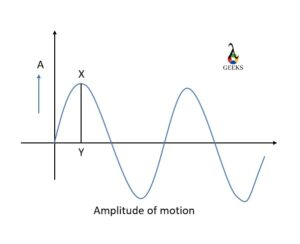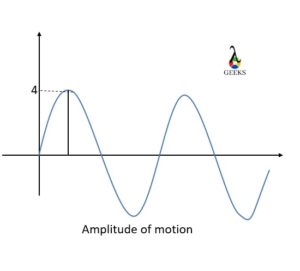Simple harmonic motion is a form of periodic motion in which an object or particle moves about its central position. Let us know what is amplitude of motion.
In SHM, when a body moves about a fixed point, it covers displacement on either side of the point. This maximum displacement covered by a particle or object is termed the amplitude of motion. There is a possibility of it being negative, which only shows the displacement in the opposite direction.
We all have seen or know that it starts vibrating for a few seconds on striking the guitar string. It first moves from its equilibrium position to one side and then goes to the other side from passing through to the equilibrium position. Now, this whole to and fro motion of the string is the periodic motion.
Here one more thing arises when the string starts vibrating, a restoring force emerges, which acts directly proportional to the particle’s displacement. Hence this is a simple example of simple harmonic motion.
In this example, the displacement of the string on either side of the central position is its amplitude. Let us understand it in a simple method. When we march past, our hands swing front and back. Now the extent to which you lift your hand will be its amplitude.

Image Credit: Pixabay

We know that the SHM is a sinusoidal wave equation. Hence the motion of a particle is represented as the wave diagram.
In this figure, we can see that the particle is making equal maximum displacement on either side. Therefore the distance XY is the amplitude of the motion. The symbol to symbolize amplitude is A, and since it is a measure of displacement, its standard unit is meter (m). There can be another unit as well, like centimeters.
How to calculate the amplitude of motion
We have understood what is amplitude of motion now; the next question that arises is how to calculate the amplitude of motion. The simple harmonic motion is a sinusoidal wave function; therefore, the SHM equation can be represented as a function of sine or cosine.
x = A sin (ωt + ϕ) or x = A cos (ωt + ϕ)
Here,
x is the displacement of the wave
A is the amplitude of motion
ω is the angular frequency
t is the period
ϕ is the phase angle
From the above equation, we can calculate the amplitude of the motion.
Suppose we are given the SHM equation as x = 2sin(4t). Now, comparing the equation with sinusoidal wave equation x = A sin (ωt + ϕ), we get amplitude as 2 metres.

For the given diagram, we can easily calculate the amplitude. From the figure, the amplitude is 5 m.
Frequently Asked Question (FAQs)
What is simple harmonic motion?
In physics, motion can be varied, like simple harmonic, wave, and circular motion.
The simple harmonic motion is the to and fro movement of a particle or object. In this motion, the restoring force acts indirectly proportional to the amplitude. Example: musical instruments, bungee jumping etc.
Is SHM the same as a periodic motion?
Periodic motion is the one in which a body repeats its motion in regular intervals.
Simple harmonic motion is a particular case of periodic motion in which, on movement, a restoring force emerges, which increases or decreases with the amplitude of the motion.
What is amplitude of motion?
To define a simple harmonic motion, we use some basic physics concepts. One of them is amplitude.
Amplitude is the maximum displacement that a body or particles complete about its central point. Suppose a bouncing ball reaches a maximum height of 50 cm, then the amplitude of the ball becomes 50 cm.
Give an example of the amplitude of motion.
The amplitude of motion is the maximum displacement of a moving body.
In the above figure, we can see that the pendulum displaces on either side till point A and B. Therefore, the distance OA and OB become the amplitude of the moving pendulum.
How to calculate the amplitude of motion?
The simple harmonic motion is a sinusoidal wave function. Its equation can be represented as s sine or cosine function.
The SHM equation is represented as:
x = A sin (ωt + ϕ) or x = A cos (ωt + ϕ)
Here,
x is the displacement of the wave
A is the amplitude of motion
ω is the angular frequency
t is the period
ϕ is the phase angle
The equation is used to calculate the amplitude of the motion.
On what factors does amplitude depend?
Amplitude depends only on the energy of the moving body.
Amplitude is directly proportional to the square root if dissipated energy. It further does not depend on any other factor of SHM like frequency or time period.
How does amplitude affect the motion?
The restoring force that emerges is directly varied to the amplitude of motion.
The rise in amplitude leads to an increase in the force, which further increases the acceleration. The amplitude does not have any effect on the frequency and angular frequency. Therefore amplitude does not affect the motion.
What is the symbol and unit of the amplitude of motion?
The amplitude of a moving particle is the distance between the central and extreme points.
The amplitude of the motion is denoted by the symbol A since it is the measure of displacement, therefore its unit meters. It gives the idea about the extent the body can move and gain the highest position.
Also Read:
- Projectile motion problems
- How to find normal force in circular motion
- Two dimensional motion examples
- Rectilinear motion examples
- Non uniform circular motion examples
- First law of motion examples
- Newtons second law of motion examples
- Projectile motion derivation
- Vertical motion examples
- Types of relative motion
Hi,
I am Rabiya Khalid, I have completed my masters in Mathematics. Article writing is my passion and I have been professionally writing for more than a year now. Being a science student, I have a knack for reading and writing about science and everything related to it.
In my free time, I let out my creative side on a canvas.